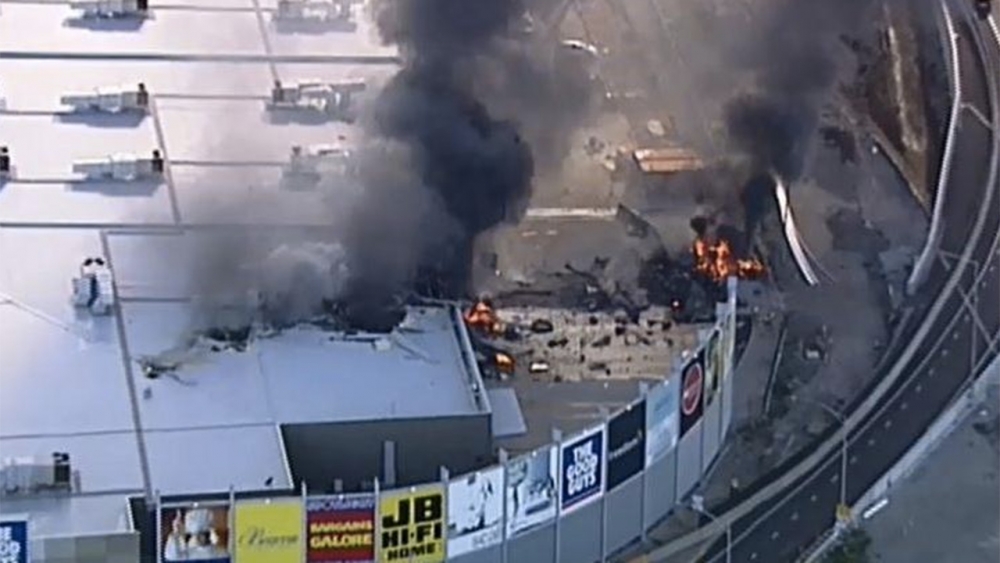The pilot of a plane involved in a fiery fatal crash in a Melbourne shopping center did not detect that a rudder setting that caused the plane to veer to the left was engaged prior to take-off, investigators have found.
Pilot Max Quartermain and four American tourists died when the Beechcraft B200 King Air aircraft crashed into a shopping complex and exploded at Melbourne’s Essendon Airport in February, 2017.
The four US nationals —Greg DeHaven, Russell Munsch, Glenn Garland and John Washburn — were on a golfing trip to King Island off the coast of Tasmania.
An Australian Transport Safety Bureau report found the aircraft took longer than expected to take off and was seen to yaw to the left after it lifted off.
It entered a shallow climb followed by a substantial left sideslip prior to it descending and hitting the shopping center.
Investigators found the pilot, who sent out a Mayday as the aircraft descended, did not detect that the rudder trim was in the full nose-left position prior to take-off.
Rudder trim is used to adjust a small panel on the rudder to allow coordinated flight without the pilot having to constantly apply pressure to the controls.
“The position of the rudder trim resulted in a loss of directional control and had a significant impact on the aircraft’s climb performance in the latter part of the flight,’’ The ATSB said.
Investigators said it was likely Quartermain was applying right rudder pedal in an attempt to compensate for the yaw induced by the incorrectly set runner trim.
‘While the ATSB was unable to quantify the rudder pedal forces required to overcome the mis-set rudder trim, when tested in a B250 class-D simulator, the forces could only be countered by the pilot for a short period of time,’’ it said.
Investigators also found Quartermain did not have appropriate pre-flight check systems in place and this “increased the risk of incorrect checklists being used, incorrect application of the aircraft’s checklists, and checks related to supplemental equipment not being performed.”
They also noted the aircraft’s cockpit voice recorder did not record the accident flight due to a tripped ‘impact switch’, which was not reset prior to the accident flight.
“This deprived the investigation of potentially valuable recorded information,” it said.
The aircraft was operated above the maximum take-off weight on the day of the accident, although this was not seen to have influenced the crash.
The report found that the presence of the building struck by the aircraft did not increase the severity of the consequences of this accident. In the absence of that building, the aircraft’s flight path would probably have resulted in an uncontrolled collision with a busy freeway, with the potential for increased ground casualties.

It also raised questions about buildings in the retail precinct that exceeded the airport’s obstacle limitation surfaces.
“The ATSB also found that the presence of the building struck by the aircraft did not increase the severity of the consequences of this accident,’’ it said. “In the absence of that building, the aircraft’s flight path would probably have resulted in an uncontrolled collision with a busy freeway, with the potential for increased ground casualties.”
In its safety message, The ATSB emphasized the importance of checklists and flight check systems.
“The ATSB encourages all pilots, no matter what your experience level, to always follow the appropriate checklist thereby preventing accidents like this in the future,” chief commissioner Greg Hood said.
“In addition to the checklists, The ATSB also considers that pilots need to carefully consider their decision making, particularly during critical phases of flight such as take-off.
“If anything is abnormal in relation to the operations during take-off, considering aborting that take-off.”
The crash is controversial because Quartermain about 18 months previously had been involved in a near collision that took him within a few hundred feet of another plane near Victoria’s Mt Hotham.
READ: Report confirms shopping center pilot in 2015 near collision.
The Mt Hotham report found Quartermain ran into difficulties as he approached the airport and had difficulties operating the GPS and autopilot.
It said “an unexpected reduction in the level of flight automation” and an increase in workload affected Quartermain’s ability to follow the established tracks such as the published approach and missed approach. He also did not communicate his position accurately to the other aircraft or air traffic control.
The pilot underwent flight testing by a Civil Aviation Safety Authority delegate and then by a flying operations inspector, who recommended remedial training before undergoing a further flight test.
He was deemed proficient and competent to resume operations after the subsequent flight test.
























